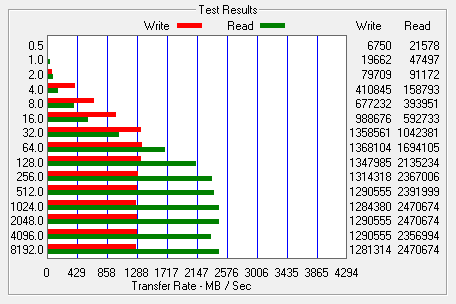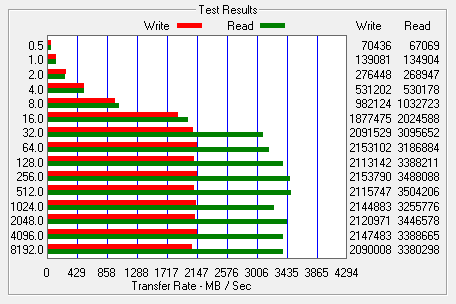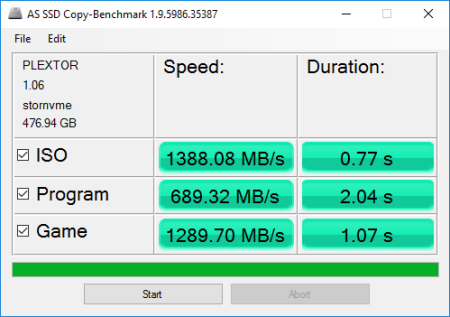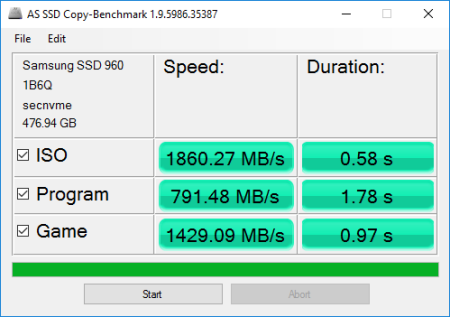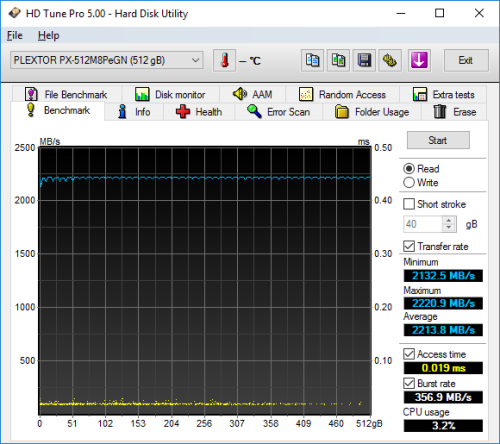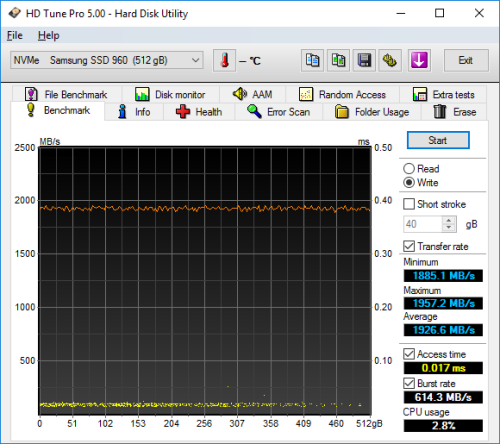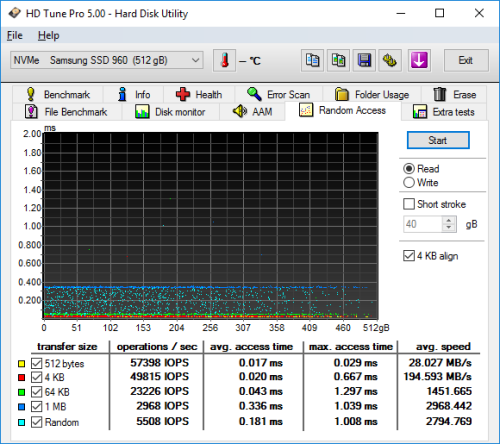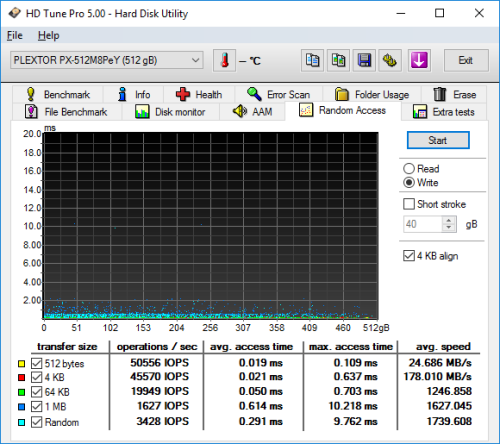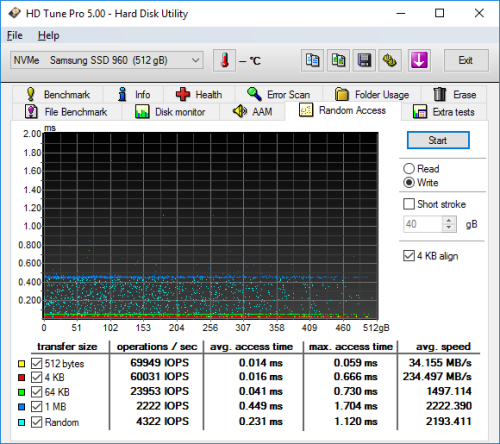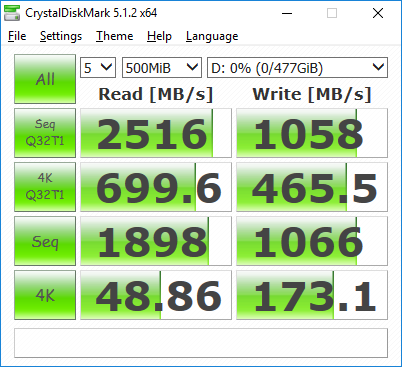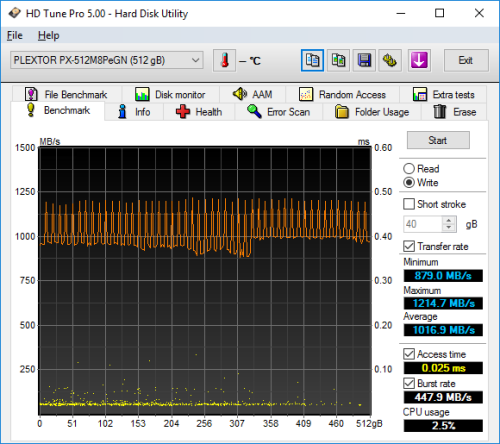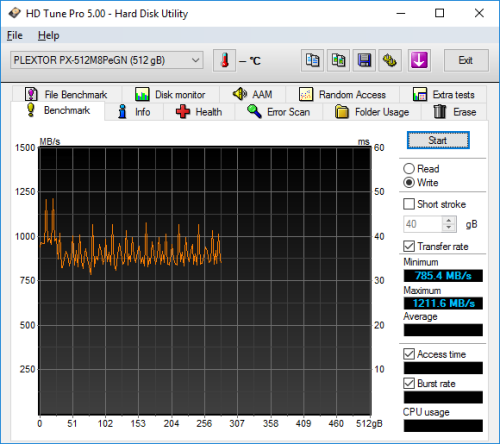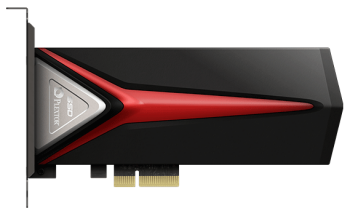

Model: Plextor M8Pe 512GB PCIe NVMe Solid State Drive
Manufacturer: Plextor
Provided By: Plextor LLC
As one of the biggest names in the storage industry, Plextor doesn't need much of an introduction. For nearly twenty years, they've produced some of the best optical drives the industry has seen. Known the world over for their quality, performance, and features, these drives have become favorites among consumers and professionals alike. Today, Plextor continues to lead the way by bringing cutting edge storage technologies to market. Along with an assortment of high-performance DVD and Blu-ray drives, the company offers a growing number of solid state drives.
With solid-state technology advancing at an ever increasing rate, Plextor has begun to look for ways to push performance beyond the limits of the current SATA specifications. In addition to technologies like PlexTurbo, which uses unused system resources to boost storage performance, the company has introduced a number of PCIe-based SSDs. The latest addition to this lineup is the M8Pe. Designed with gamers and professionals in mind, this NVMe 1.2 compliant, M.2 form factor drive is powered by Marvell's 88SS1093 "Eldora" controller and is available with up to 1TB of Toshiba's 15nm Toggle MLC NAND flash. The M8Pe also uses a PCIe Gen3 x4 lane interface to deliver up to 2,500 MB/s read and 1,400 MB/s write speeds along with a maximum of 240,000 random write IOPS.
The M8Pe is offered in a wide range of capacities and not one or two, but three different configurations. The drive is available by itself in the M.2 2280 form factor (M8PeGN), with a small aluminum heatsink (M8PeG) and as a PCIe add-in card (M8PeY) that's equipped with an extra large heatsink and LED lighting. For this review, Plextor sent us the 512GB version of the add-in card, which is capable of delivering up to 2,300 MB/s sequential read and 1,300 MB/s sequential write speeds along with up to 260,000 random read and 250,000 random write IOPS.
| Plextor M8Pe 512GB PCIe NVMe Solid State Drive | |||||||||||||||||||||||||||||||||||||||
General Specifications
Performance
Environment and Reliability
Dimensions and Weight
Other Features
|
Needless to say, this is only a taste of what the M8Pe has to offer. To give you an idea of what to expect, we'll take a closer look at Plextor's new NVMe SSD and then see how well it performs. Does the M8Pe have what it takes? Can it deliver the performance and features that we've come to expect from Plextor? Keep reading as we find out.
The HHHL (Half-Height/Half-Length) version of the M8Pe comes packaged in an attractive black and red box. The front advertises key features like the drive's 512GB capacity, support for NVMe and Plextor's TrueSpeed and TrueProtect technologies. The back of the box provides a bit more information regarding the M8Pe's features, specifications and box contents.
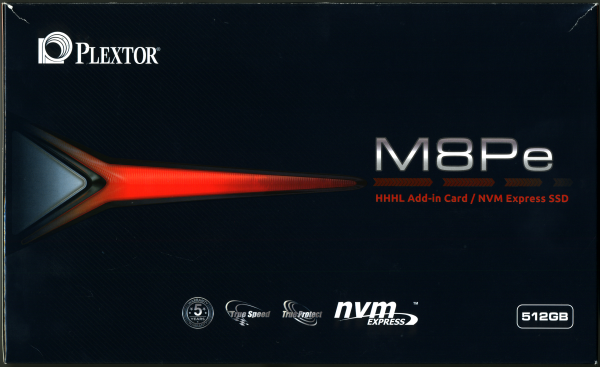

Inside the box, you'll find the M8Pe, a low profile, half height bracket for use in servers and small form factor PCs, an invitation to Plextor's VIP club, and a fold out guide containing warranty information as well as some brief installation instructions.
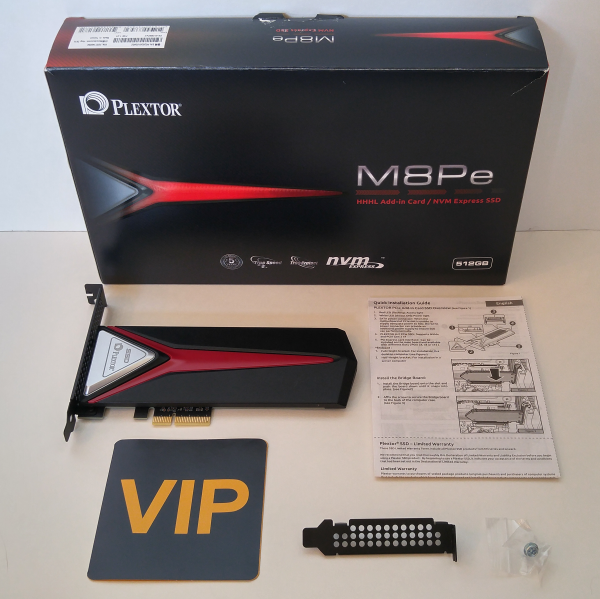
Physical Features:
When it comes to the M8Pe's construction, Plextor hasn't cut any corners. The top of the PCIe card is covered entirely by a massive aluminum heatsink which has a nice matte black finish. The M8Pe also has a sporty red stripe down the middle as well as a silver triangle with the Plextor logo that lights up when the drive is powered on.

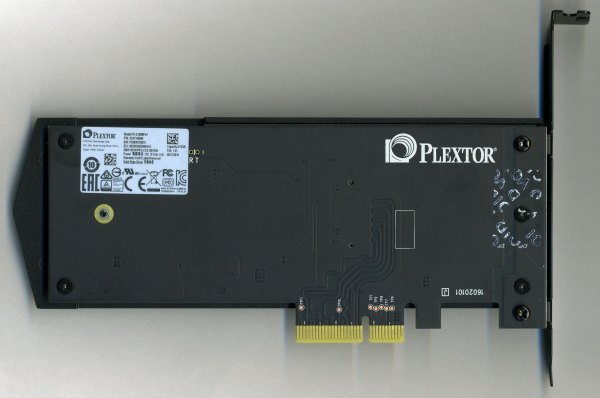
If you want to void your warranty, the heatsink can be removed by taking out a few of the screws on the back of the card. With it removed, you can see the thermal pads that Plextor has sandwiched in between the drive and heatsink.

With the heatsink out of the way, you can see the LED's on the PCIe card. In addition to the triangle shaped array that lights up when the drive is powered on, there is a strip along the top that flashes to show drive activity. The card also has an additional SATA power connector in case your motherboard's PCIe slot is unable to supply adequate power to the SSD. From my experiences, I found the extra connector to be unnecessary.

As I mentioned earlier, the M8Pe uses Marvell's 88SS1093 controller. This 8 channel, PCIe Gen 3 x4 NVMe SSD controller is equipped with three ARM Cortex R5 cores and features support for 15nm TLC/MLC/SLC and 3D NAND. The 88SS1093 also integrates Marvell’s third generation NANDEdge error-correcting, low-density parity check (LDPC) technology for higher reliability and endurance.


For the 512GB version of the M8Pe, Plextor used Toshiba's 15nm Toggle Mode MLC NAND flash. Looking at the pictures above, you can see that there are two 256GB NAND flash packages on the top of the PCB. The drive also has a single Samsung 512MB LPDDR3 DRAM memory chip that is used for caching.
The test system used in this review is equipped with an Intel Core i7-6700K CPU, GIGABYTE GA-Z170X-UD3 motherboard, 32GB (16GB x 2) of Crucial Ballistix Sport LT DDR4 memory, Plextor SU800 512GB SSD and a GIGABYTE GeForce GTX 1060 WINDFORCE OC 6G graphics card. For the operating system, I installed a fresh copy of Windows 10 Enterprise.
To test the performance of Plextor's M8Pe SSD, I ran a series of benchmarks using CrystalDiskMark, HD Tach RW, ATTO Disk Benchmark, AS SSD, HD Tune Pro, Anvil's Storage Utilities, Iometer and PCMark 8. For comparison, I've also included test results from the ADATA XPG SX8000, Samsung 960 PRO, Toshiba OCZ RD400, Samsung 950 PRO, Toshiba OCZ VX500, Plextor Ultimate SU800, Plextor S2C, Crucial M300, Plextor M7V, PNY CS1311, OCZ Trion 150, PNY CS2211, Plextor M6V, Crucial BX200, OCZ Trion 100, Kingston HyperX Savage, Crucial MX200, OCZ Vector 180, Samsung SSD 850 EVO and Samsung SSD 850 PRO.

As I mentioned earlier, the M8Pe is based on Marvell's 88SS1093 controller chip. Looking at the screenshot above, you can see that it performs equally well with both incompressible (0%) and compressible (100%) data.
CrystalDiskMark 5.1.2:
First, I ran a few quick tests using CrystalDiskMark. This benchmark tool measures the performance of a storage device by testing its sequential read and write speeds as well as its random read and write speeds using blocks 512K and 4K in size.
According to Plextor, the 512GB version of the M8Pe is capable of reading at 2,300 MB/s and writing at 1,300 MB/s. While the drive performed better than expected when reading, it came up a bit short in CrystalDiskMark's sequential write speed test.
HD Tach RW 3.0.4.0:
Next, I used HD Tach to test the M8Pe's read, write and burst speeds as well as its seek times and CPU usage.
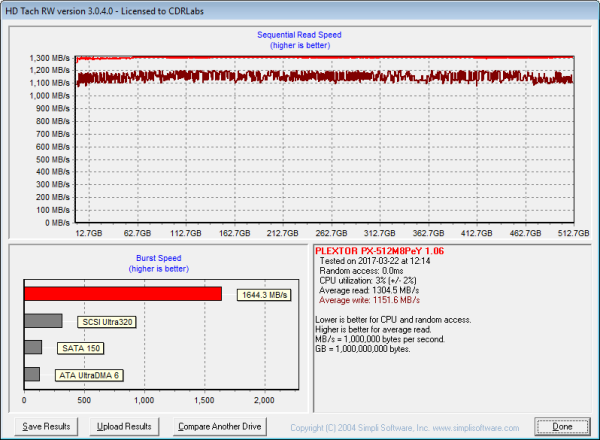
Plextor M8Pe 512GB
The M8Pe's performance was hit and miss when tested with HD Tach. While the drive was able to write at 1,151.6 MB/s, its read speed averaged out at only 1304.5 MB/s.
ATTO Disk Benchmark 2.46:
I also used ATTO Disk Benchmark to test the M8Pe's sequential read and write speeds. The tests are run using blocks ranging in size from 0.5KB to 8192KB and the total length set to 256MB.
When tested with ATTO, the M8Pe's read speeds topped out at about 2,470 MB/s and its write speeds at 1,290 MB/s.
AS SSD:
AS SSD is a relatively new benchmark designed specifically for solid state drives. The application contains five synthetic tests used to determine the sequential and random read and write performance of a drive.
AS SSD also includes a copy benchmark. This test copies an ISO (two large files), program (many small files) and game (small and large files), returning the speed and duration of each.
HD Tune Pro 5.00:
Next, I ran a series of tests using HD Tune Pro. This hard disk utility measures a drive's performance by testing its sequential read and write speeds as well as its access time, burst rate and CPU usage. For this review, I'm also going to use it to benchmark the M8Pe's random read and write speeds, random access times and the number of operations per second.
The M8Pe performed very well when benchmarked with HD Tune. The drive had average read and write speeds of 2213.8 MB/s and 976.6 MB/s, respectively, and a burst rate of 356.9 MB/s when reading.
The M8Pe didn't disappoint when doing random reads and writes. When writing 4KB blocks, the drive reached 45,570 IOPS and had an average speed of 178.010 MB/s. It was even faster when reading, reaching 48,316 IOPS with an average speed of 188.735 MB/s.
Anvil's Storage Utilities:
Anvil's Storage Utilities is another benchmark designed with SSDs in mind. The standard storage benchmark measures a drive's performance by testing its transfer speeds, access times and IOPS.

Iometer:
Lastly, I ran a series of tests using Iometer. This tool can be configured to benchmark a number of things. In this case, I used it to measure the M8Pe's read and write speeds and the number of operations per second. The tests were run using random bytes and a queue depth of 3.

The M8Pe's performance was very similar to what we saw in our other tests. The drive was able to read at 2052.45 MB/s and write at 1206.09 MB/s.

The M8Pe also performed very well when doing random reads and writes. In our tests, the drive was able to read at 260.88 MB/s and write at 673.77 MB/s.

According to Plextor, the 512GB M8Pe is capable of up to 260,000 IOPS when reading and 250,000 IOPS when writing 4K blocks. In our tests, the drive reached 66,784 random read IOPS and 172,486 random write IOPS. As with most drives, the M8Pe performed better at higher queue depths. With the queue depth set to 32, it reached 275,244 random read IOPS and 235,167 random write IOPS.
PCMark 8 - Storage Test:
PCMark 8 is a complete benchmark for Windows. It includes five benchmark tests, each designed around a specific scenario. The storage benchmark measures drive performance using real-world traces recorded from Adobe Creative Suite, Microsoft Office and a selection of popular games.

PCMark 8 also includes a consistency test which measures the performance consistency and degradation tendency of a storage system. The test reports the performance level at the start, the degraded steady-state and the recovered state as well as the number of iterations required to reach the degraded state and the recovered state. For this test, we are focusing on the Adobe Photoshop (Heavy) trace and will look at both the bandwidth and latency of the drive
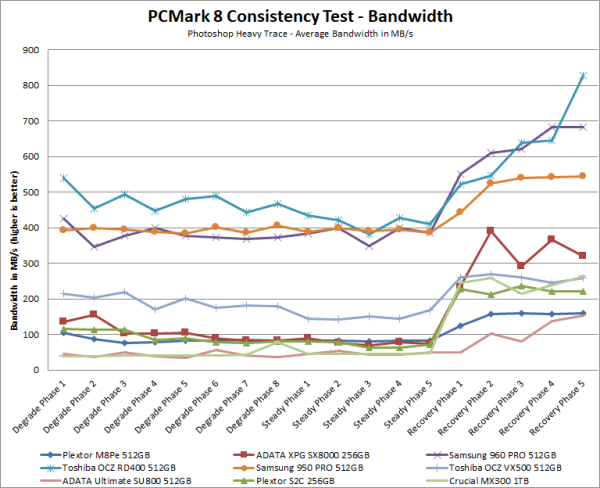

The M8PE didn't do as well as the other PCIe SSDs in this test. Its bandwidth dropped below 90 MB/s during the degradation and steady phases, pushing its latency above the 350ms mark. The M8Pe performance increased somewhat during the recovery phase. However, it still lagged behind most of the other drives, topping out at only 152 MB/s.
TRIM Performance:
While SSD's offer many benefits, there are some downsides to using flash memory. One of the biggest issues people run into is performance degradation. Over time, an SSD will run out of fresh blocks and will have to write over data the file system has marked as deleted. This procedure is very complicated and can slow an SSD's write speeds considerably.
To fix this problem, most manufacturers have added TRIM support to their SSDs. The TRIM command allows an operating system, such as Windows 7, to tell an SSD which data blocks are no longer in use. Using this information, the drive pro-actively erases these blocks and adds them to the free block pool.
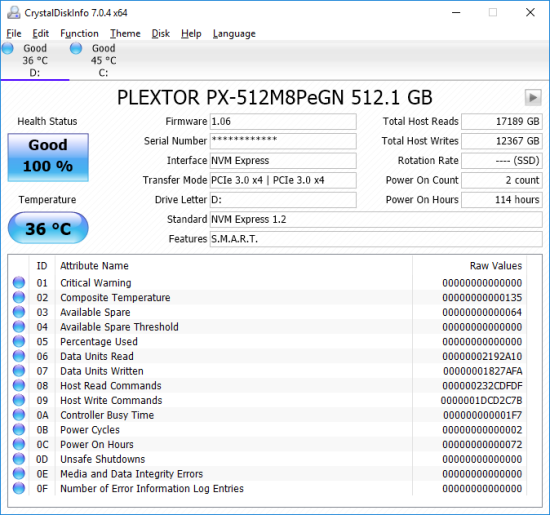
To test the M8Pe's TRIM and garbage collection functions, I first put the drive in a "dirty" state. I used Iometer to fill the entire drive and then ran a random write test for 30 minutes. Looking at the screenshot below, you can see that the M8Pe's average read and write speeds dropped to 365.1 MB/s and 254.0 MB/s, respectively.

Plextor M8Pe - Dirty
To see how well the M8Pe could recover, I let the computer sit for about 30 minutes and then reran the test. The drive's average write speed jumped up to 563.6 MB/s. However, its average read speed lagged behind, averaging out at only 443.5 MB/s.

Plextor M8Pe - After TRIM
Lastly, I used Parted Magic to perform a secure erase on the M8Pe. With the drive wiped clean, it had average read and write speeds of 1284.7 MB/s and 579.5 MB/s, respectively.
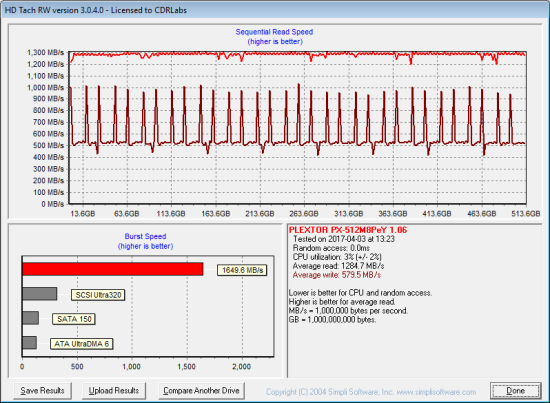
Plextor M8Pe - Secure Erased
I'd be remiss if I didn't mention the ongoing problem we've had with the M8Pe. When we received the drive last fall, I quickly realized that it was not performing as well as it should. Instead of being able to write at 1,300 MB/s, our test unit topped out at about 1,050 MB/s.
I knew that Plextor had run into some compatibility issues with the M8Pe and certain motherboards and chipsets so I tried a few other computers. This did not solve the problem, nor did switching the BIOS from legacy to UEFI or upgrading the OS and chipset drivers. I even went as far as to take the M8Pe off of the HHHL PCIe card and pop it into the M.2 slot on the motherboard, which had no effect.
Eventually, I reached out to Plextor and explained the situation to them. Initially, they thought the problem could be heat related, but with the M8Pe's massive heatsink and the extra fans I added, this was quickly eliminated. The theory then was that it was a problem with the drive's garbage collection algorithm which Plextor "improved" in the 1.02 firmware update.
While this theory made sense, the folks at Plextor had a hard time reproducing the problem. After much back and forth, I sent my review unit back to them. By pulling the the internal logs and running a trace on the drive, their engineers were able to determine that it was a garbage collection issue. For whatever reason, the algorithm was being triggered earlier than necessary and this was impacting the drive's write performance.
By this time, the holidays were upon us and I put the M8Pe on the back burner until Plextor could come up with a fix. In mid February, Plextor released the 1.05 firmware and I was surprised to see no mention of the garbage collection issue in the change log. Instead, it fixed an issue with the drive's sleep mode. I reached out to Plextor once again, asking where they were with the fix and they let me know that it was more difficult than they expected. However, they should have something soon.
Thankfully, I didn't have long to wait. In early March, Plextor let me know that they had the new firmware ready and wanted me to test it. While they didn't give any real specifics, the change log said the 1.06 firmware improved the background garbage collection algorithm. Initially, things looked good with the new firmware but after awhile, performance dropped off once again.
The point where it drops off is fairly consistent. With HD Tune, it's after you write about 530GB worth of data. With Iometer, it was slightly less at about 524GB. Either way, the M8Pe's performance never recovered. At one point, I let the drive sit idle for an entire weekend and aside from a slight blip at the start of the benchmark, its write speed stayed at about 1,050 MB/s. Needless to say, the garbage collection algorithm still wasn't working as it should.
I am still working with Plextor on this problem but, after nearly six months, I'm starting to wonder whether this will, or even can, be fixed. I'm just hoping that the company's next PCIe SSD, the M8Se, does not have the same issues when it's released in June.
Final Thoughts:
By now, I've spent a lot of time with the Plextor M8Pe and, despite some of the issues I've had, I can't help but to like the drive. This gamer-oriented, PCIe SSD offers good performance, a bold, eye catching design and a massive heatsink to keep it cool during lengthy gaming sessions. Internally, the M8Pe is powered by Marvell's 88SS1093 controller and is available with up to 1TB of Toshiba's 15nm Toggle MLC NAND flash. Combine this with a NVMe 1.2 certified, PCIe Gen 3.0 x4 interface and you have an SSD capable of reading and writing at speeds well beyond that of a single SATA-based drive. In our sequential read and write tests, the M8Pe was able to read at speeds as high as 2,518 MB/s and write at speeds in excess of 1,206 MB/s. The drive also did quite well in our random write tests, producing more than 172,000 IOPS at low queue depths.
That being said, the M8Pe is not without its downsides. First and foremost, is the garbage collection problem, which still has not been fully resolved. Given, the M8Pe is still pretty fast with its write speed throttled back. However, this probably isn't going to sit well with the gamer or enthusiast who bought the drive because its rated write speed was higher than other PCIe SSDs. In addition to this, the M8Pe lacks any sort of hardware based encryption and is not supported by Plextor's PlexTool software.
The M8Pe is available now in 128GB, 256GB, 512GB and 1TB capacities. Prices on Amazon currently range from $80 up to $480, with the 512GB HHHL version reviewed here going for about $300.
Highs:
- PCIe 3.0 x4 interface with NVMe protocol
- Equipped with Toshiba Toggle MLC NAND
- Available in 128GB, 256GB, 512GB and 1TB capacities
- Good sequential and random read and write performance
- M.2 2280 and HHHL PCIe form factors
- Supports TrueSpeed and TrueProtect technologies
- Large DRAM cache
- Competitively priced
- 5 year warranty
Lows:
- Garbage collection problem limits maximum write speed
- Not supported by Plextor's PlexTool software
- Does not support hardware based encryption


